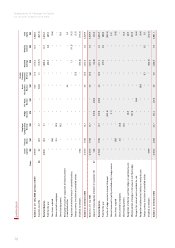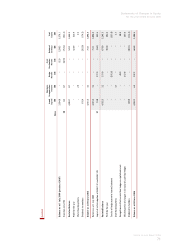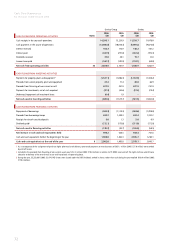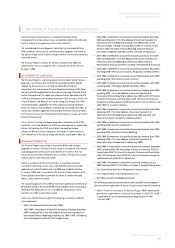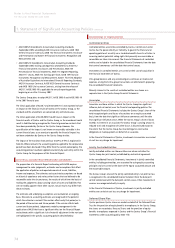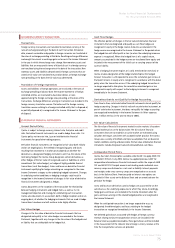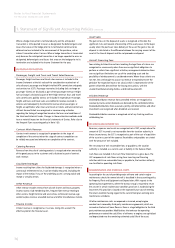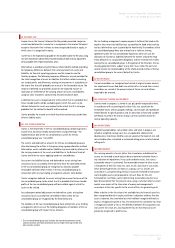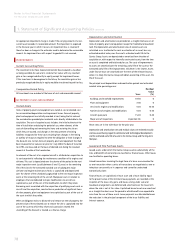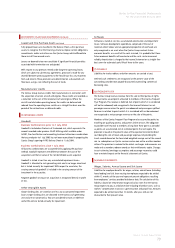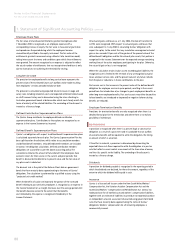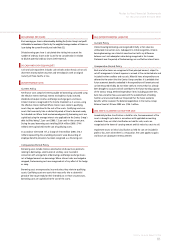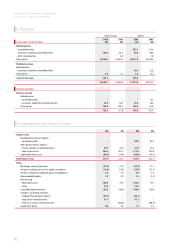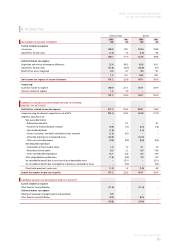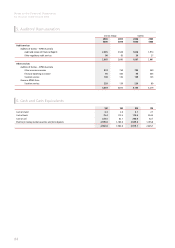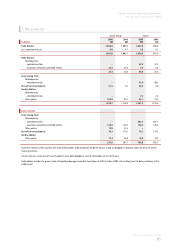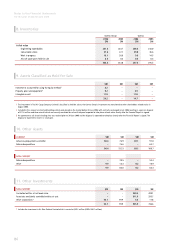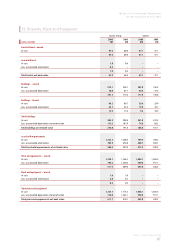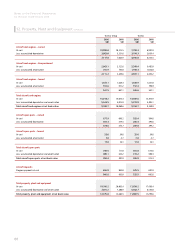Qantas 2006 Annual Report Download - page 81
Download and view the complete annual report
Please find page 81 of the 2006 Qantas annual report below. You can navigate through the pages in the report by either clicking on the pages listed below, or by using the keyword search tool below to find specific information within the annual report.
79
Qantas Annual Report 2006
Notes to the Financial Statements
for the year ended 30 June 2006
(R) PROPERTY, PLANT AND EQUIPMENT CONTINUED
Leased and Hire Purchase Assets continued
Fully prepaid leases are classified in the Balance Sheet as hire purchase
assets, to recognise that the financing structures impose certain obligations,
commitments and/or restrictions on the Qantas Group, which differentiate
these aircraft from owned assets.
Leases are deemed to be non-cancellable if significant financial penalties
associated with termination are anticipated.
With respect to any premises rented under long-term operating leases,
which are subject to sub-tenancy agreements, provision is made for any
shortfall between primary payments to the head lessor less any recoveries
from sub-tenants. These provisions are determined on a discounted cash
flow basis, using a rate reflecting the cost of funds.
Manufacturers’ credits
The Qantas Group receives credits from manufacturers in connection with
the acquisition of certain aircraft and engines. These credits are recorded as
a reduction to the cost of the related aircraft and engines. Where the
aircraft are held under operating leases, the credits are deferred and
reduced from the operating lease rentals on a straight line basis over the
period of the related lease as deferred credits.
(S) INTANGIBLE ASSETS
Goodwill
Business Combinations prior to 1 July 2004
Goodwill is included on the basis of its deemed cost, which represents the
amount recorded under previous GAAP. Utilising relief available under
AASB1, the classifi cation and accounting treatment of business combinations
that occurred prior to 1 July 2003 has not been reconsidered in preparing the
Qantas Group’s opening A-IFRS Balance Sheet at 1 July 2004.
Business Combinations since 1 July 2004
All business combinations are accounted for by applying the purchase
method. Goodwill represents the difference between the cost of the
acquisition and the fair value of the net identifiable assets acquired.
Goodwill is stated at cost less any accumulated impairment losses.
Goodwill is allocated to cash generating units and is no longer amortised
but is tested annually for impairment. With respect to associates, the
carrying amount of goodwill is included in the carrying amount of the
investment in the associate.
Negative goodwill arising on an acquisition is recognised directly in profit
or loss.
Other Intangible Assets
Airport landing slots are stated at cost less any accumulated impairment
losses. Airport landing slots are allocated to the Qantas cash generating
unit and are not amortised as they are considered to have an indefinite
useful life and are tested annually for impairment.
Software
Software is stated at cost less accumulated amortisation and impairment
losses. Software development expenditure, comprised of the cost of
materials, direct labour and an appropriate proportion of overheads are
only recognised as an asset when the Qantas Group controls future
economic benefits as a result of the costs incurred, it is probable that those
future economic benefits will eventuate and the costs can be measured
reliably. Amortisation is charged to the Income Statement on a straight-line
basis over the estimated useful life of three to five years.
(T) PAYABLES
Liabilities for trade creditors and other amounts are carried at cost.
Deferred cash settlements are recognised at the present value of the
outstanding consideration payable discounted at prevailing commercial
borrowing rates.
(U) FREQUENT FLYER
The Qantas Group receives revenue from the sale to third parties of rights
to have Qantas award points allocated to members of the Qantas Frequent
Flyer Program. This revenue is deferred (net of points which it is considered
will not be redeemed) and recognised in the Income Statement as net
passenger revenue when the points are redeemed and passengers uplifted.
Revenue in relation to points which it is considered will not be redeemed
are recognised as net passenger revenue on the sale of the points.
Members of the Qantas Frequent Flyer Program also accumulate points by
travelling on qualifying Qantas and partner airline services. The obligation
to provide travel rewards to members arising from these points is provided
as points are accumulated, net of estimated points that will expire. The
provision is based on the present value of the expected incremental direct
cost (being the cost of meals and passenger expenses) of providing the
travel rewards based on the forecasted weighted average cost of the reward
mix i.e. redemptions on Qantas services and on non-airline or other member
airlines. The provision is reduced to the extent surcharges and recoveries are
made and as members redeem awards or their entitlements expire. Changes
in cost estimates, breakage assumptions and passenger recoveries could
have a material impact on the fi nancial statements of Qantas.
(V) EMPLOYEE BENEFITS
Wages, Salaries, Annual Leave and Sick Leave
Liabilities for employee benefits for wages, salaries, annual leave (including
leave loading) and sick leave vesting to employees expected to be settled
within 12 months of the year end represent present obligations resulting
from employees’ services provided to balance date. The calculation of this
liability is based on remuneration wage and salary rates that the Qantas
Group expects to pay as at balance date including related on-costs, such as
workers’ compensation insurance, superannuation and payroll tax. Amounts
expected to be settled more than 12 months after year end are not
discounted to their present value.



